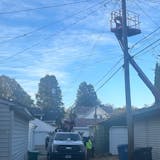Long before the trumpeter's Call to the Post echoes throughout Canterbury Park on a summer evening, many of the facility's employees have already put in a full day's work in order to take care of the 1,550 horses that live on the grounds. ¶ More than 600 call the stables — hidden by the tiered grandstand overlooking the Shakopee track — their office. They might never be seen by the crowds that flock to the races, but these employees have created livelihoods by performing the dirty jobs that keep race days running.
Larry Davila, gate crew
It might be the most dangerous job on the racetrack, Larry Davila says, but 50 years ago, being on a gate crew was like being a part of an elite club. So when Davila, who exercised horses in the 1960s, was offered a job working at a gate, he jumped at the chance.
"I only weighed 130 pounds," said Davila, who has been the starter at Canterbury Park for 19 years. "I had to make those horses think I really loved them because I wasn't big enough to fight them."
Now Davila, 68, has a team of 11 assistants who work together in order to get the horses into the starting gate before each race. On most days at 7 a.m., Davila's team will spend an hour standing horses that have misbehaved in the gate before races. Then for another hour, they'll work on breaking young horses that are being trained to race for the first time.
The assistants, who weigh but a fraction of the often-unhappy animals they attempt to train, are dressed head to toe in gear to protect them against uncooperative horses. The job of wrangling the horses is a lot safer now than when he did it with little protective gear, Davila said.
His crew members sustain bumps and bruises on a regular basis. Only a few weeks ago, a 230-pound assistant was kicked by a horse and sent flying. Despite the danger involved, Davila said he feels privileged to do his job. It's everything he dreamed it would be from a young age.
"And then some," Davila said.
Don Bridge, pool operator
At first glance, the 12-foot-deep swimming pool at Canterbury Park looks just like any other put to use on a hot summer day. Put a 1,000-pound horse in it, however, and Don Bridge's job is a bit different from the average pool operator's.


